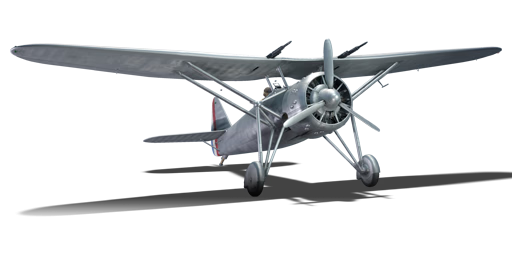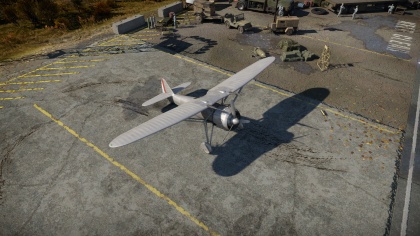D.371 H.S.9
Contents
| This page is about the French reserve fighter D.371 H.S.9. For other uses, see D.37 (family). |
Description
The D.371 H.S.9 is a gift rank I premium French fighter
with a battle rating of 1.7 (AB) and 1.3 (RB/SB). This aircraft was introduced in Update 1.73 "Vive la France".
In the early 1930s, SAF-Avions Dewoitine, a French aircraft manufacturing company developed the D.37 aircraft, a single-seat airplane with a parasol wing, radial engine, fixed landing gear and a tail-skid; however, the actual manufacturing of the aircraft was transferred to Lioré et Olivier. The cockpit did not have an enclosed canopy; just a windshield forward of the pilot.
The D.371 H.S.9 was a modification of the first production version of this aircraft line which was first flown in 1934 powered by a Gnome Rhône 14Kfs radial engine and also featured wheel breaks. This aircraft had 2 x 20 mm Hispano-Suiza 9 cannons installed, with one mounted underwing, each on opposites sides of the fuselage from each other. Limitation of 30 rounds per gun (60 total) requires the pilot to be spot-on with their shots to make each one count.
General info
Flight Performance
| Characteristics | |||||||
|---|---|---|---|---|---|---|---|
| Stock | |||||||
| Max Speed (km/h at 3,000 m) |
Max altitude (meters) |
Turn time (seconds) |
Rate of climb (meters/second) |
Take-off run (meters) | |||
| AB | RB | AB | RB | AB | RB | ||
| 379 | 372 | 9,000 | ? | ? | 7.7 | 9.7 | 150 |
| Upgraded | |||||||
| Max Speed (km/h at 5,000 m) |
Max altitude (meters) | Turn time (seconds) | Rate of climb (meters/second) |
Take-off run (meters) | |||
| AB | RB | AB | RB | AB | RB | ||
| ? | ? | 9,000 | 20 | 20.6 | ? | ? | 150 |
Details
| Features | ||||
|---|---|---|---|---|
| Combat flap | Take-off flap | Landing flap | Air brakes | Arrestor gear |
| X | X | X | X | X |
| Limits | ||||
|---|---|---|---|---|
| Wing-break speed (km/h) |
Gear limit (km/h) |
Combat flap (km/h) |
Max Static G | |
| + | - | |||
| 560 | 560 | X | ~12 | ~6 |
| Optimal velocities | |||
|---|---|---|---|
| Ailerons (km/h) |
Rudder (km/h) |
Elevators (km/h) |
Radiator (km/h) |
| < 280 | < 360 | < 260 | > 210 |
| Compressor (RB/SB) | ||
|---|---|---|
| Setting 1 | ||
| Optimal altitude | 100% Engine power | WEP Engine power |
| 3,825 m | 880 hp | 1,023 hp |
Survivability and armour
- No armour plating
- No armour glazing
- Open cockpit
- Critical components located at front of aircraft (fuel, pilot, engine, controls)
Early aircraft did not feature much in the way armoured protection as many of the aircraft were at this point were transitioning from the wood frame and cloth skin to the wood frame and metal skinned aircraft. Due to the balancing of the aircraft, much of the critical equipment was positioned towards the front of the aircraft, where the engine, fuel tanks, oil pumps, control linkages and the pilot were clustered around each other. With this tight grouping and no armour protection, when fired upon, chances were high to hit a critical component in the aircraft.
Armaments
Offensive armament
Each of the two cannons are bundled with one on each side of the fuselage, mounted to the underside of the wing. Each machine gun is outfitted with the same amount of ammunition, which means that all guns will fire with each other until empty. Due to the mounting locations on the wings (just outside of the propeller arc) and closer together than the machine guns on other models, convergence in this aircraft is not as critical, but still necessary. Most of the fighting with this aircraft will be in close quarters to exploit the explosive power of the cannons in close range. Convergence set between 150 and 300 meters (where ever you are most comfortable) will work best along with careful aim to put the most bullets into the enemy aircraft as possible and hit a critical component. Many pilots in World War I and II would set their weapon's convergence to 200 to 250 meters and would wait until being in that range before firing to ensure best chances for shooting down the enemy. Shots from too far away could "spook" the enemy into evasive manoeuvres or just waste ammunition in a "spray and pray" manoeuvre which one cannot afford with this aircraft. Practice and skill will allow the pilot to close within 250 m of the enemy and take them out with controlled bursts and then move onto the next victim.
Usage in the battles
Maintaining speed with this aircraft is a must as a slow D.371 is an easy target. Initial spawning into a map should lead a D.371 pilot to climb and gain altitude. This will give you an advantage over most other pilots upon reaching the combat area as you will select which enemy plane to dive on and attack. With a diving attack, you will gain speed which will allow you to quickly gain on the enemy aircraft fire off a burst of rounds and then climb back up for altitude. If you decide to tail an enemy plane after a dive, you will risk bleeding off your energy. When attacking an enemy plane, attempt to attack when you see the greatest surface area of the fuselage and wings. If tailing a fighter, wait for them to turn or pull-up to expose the most surface area. When turn fighting or looping, utilize your rudder to sharpen your turning ability.
Manual Engine Control
| MEC elements | ||||||
|---|---|---|---|---|---|---|
| Mixer | Pitch | Radiator | Supercharger | Turbocharger | ||
| Oil | Water | Type | ||||
| Not controllable | Controllable Automatic pitch |
Controllable | Not controllable | Combined | Controllable | Not controllable |
Modules
As a gift vehicle, this aircraft comes fully modified.
Pros and cons
Pros:
- Very maneuverable
- Roll rate is above average
- Adequate climb rate for a rank I fighter
- A smaller target compared to most biplanes
- 2 x 20 mm Hispano cannon
- Effective against bombers
- Use stealth belt against biplanes with devastating results
Cons:
- Most rivals are faster at this point
- Out-turned by biplanes
- Continuous firing of cannons results in aircraft pulling up
- Weak structure
History
Describe the history of the creation and combat usage of the aircraft in more detail than in the introduction. If the historical reference turns out to be too big, take it to a separate article, taking a link to an article about the vehicle and adding a block "/ historical reference" (example: https://wiki.warthunder.com/Name-vehicles/historical reference) and add a link to it here using the main template. Be sure to include links to sources at the end of the article.
Media
War Thunder News - October 11, 2017 - Dewoitine D.371: Aerial Trickster
Read also
Links to the articles on the War Thunder Wiki that you think will be useful for the reader, for example,
- reference to the series of the aircraft;
- links to approximate analogues of other nations and research trees.
ETC.
Sources
Paste links to sources and external resources, such as:
- topic on the official game forum;
- page on aircraft encyclopedia;
- other literature.
| France fighters | |
|---|---|
| Dewoitine | D.371 · D.371 H.S.9 · D.373 · D.500 · D.501 · Pallier's D.510 · D.520 |
| Morane-Saulnier | M.S.405C1 · M.S.406C1 · M.S.410 |
| Arsenal | V.G.33C-1 |
| Bloch | M.B.152C1 · M.B.157 |
| Caudron | C.R.714 |
| Sud-Ouest | S.O.8000 Narval |
| American | H-75A-1 · H-75A-4 · ▄P-39Q-25 · ▄P-40F-5 Lafayette · ▄P-47D-22-RE · ▄P-63C-5 · F-6C-10-NA |
| ▄F6F-5 · ▄F6F-5N · F4U-7 · ▄F8F-1B | |
| Other countries | ▄Seafire LF Mk.III · ▄Yak-3 · Challe's ▄Yak-9T · NC.900 |
| Belgium | ▄Gladiator Mk I · ▄Spitfire FR Mk XIVe |
| Netherlands | ◘Sea Fury FB 51 |





